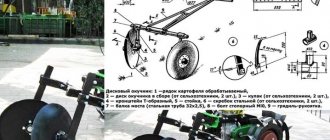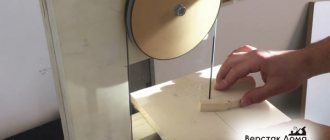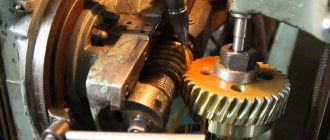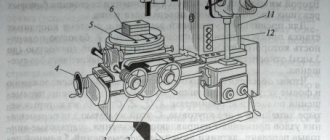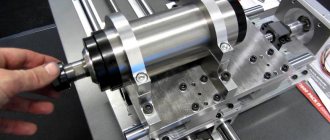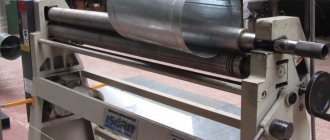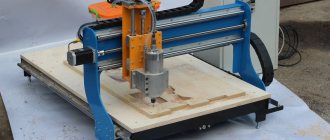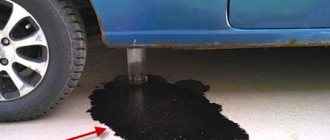Structure of the apparatus
The basis of a balancing machine is the supports on which the workpieces and sensors are installed to determine their balance. During testing, the level of imbalance is determined, and based on this information, further actions are taken.
Depending on the type of support, balancing machines are divided into soft and hard. The first measure the parameters of the wheel, taking into account the vibrations of the supports. At the same time, the device is additionally configured for each detail, which allows for fairly accurate testing.
Rigid wheel balancing machines are capable of testing different types of parts with the same equipment. This is very convenient, but the quality of measurements can be seriously affected.
In both the first and second versions of the device, the speed sensor plays a special role. No less important for such a machine is the sensor that measures the rotation angles. Depending on the information input option, balancing devices can be manual or automatic.
What is this?
Photo of balancing machine
Before purchasing a Hofmann balancing machine or a device of this type such as Patriot, Hoffman, Storm LS 11, Civic, AE T, VM 300, TS 500, SV1930v, Sivik Galaxy, Beissbarth, you should learn about the very concept of balancing.
- If wheels, driveshafts, or rotors are unbalanced, then their geometric center will not coincide with the center of mass;
- When unbalanced wheels and cardan shafts rotate, serious centrifugal force occurs;
- It causes the car or machine to begin to vibrate seriously;
- Increased vibration leads to active wear of rubber and suspension;
- By balancing cardan shafts using a balancing machine Nordberg, Hoffmann, Storm LS 11, Civic, AE T, VM 300, TS 500, SV1930v, Sivik Galaxy, Beissbarth, you will be able to avoid uneven wear of the wheels and increase the service life of the entire suspension;
- Balancing should be carried out before changing tires from summer to winter and vice versa.
To perform proper balancing you will need a special device. Which type to choose is up to you. Among the market leaders are the Hofmann balancing machine, as well as the Storm LS 11, Civic, AE T, VM 300, TS 500, SV1930v, Sivik Galaxy, Beissbarth machines.
Device Features
Balancing machine diagram drawing
A quick-release nut, special balancing rings and other elements can be an integral part of the tire mounting installation. Before you start working with your own hands on a passenger car or truck, you should learn more about the device of the balancing machine.
Read also: What current should you charge nickel metal hydride batteries?
When checking cardan shafts, rotors, and car wheels with your own hands in a tire shop, a certain principle applies, based on the design:
- The design includes supports for installing wheels;
- The electric motor is responsible for imparting rotation to the parts being tested - wheels, cardan shafts, rotors, etc.;
- Measurement sensors monitor the detection of inaccuracies in settings. Sensors monitor pressure and vibration readings;
- Having received the necessary information, balancing is performed.
In this case, the supports used in the design of the machine for cars can be of two types.
- Soft. During the inspection, the frequency of movement of the supports and the amplitude parameters are tested. There are special units for each type of driveshafts, rotors, and car wheels being tested. This increases the accuracy of the check.
- Tough. They take into account the rotor phase and pressure. With one machine you can check different parts. This is a universal device, but the principle of its operation does not allow it to demonstrate similar accuracy with structures on soft supports.
There are several more important points that you should know about when choosing a machine and working with it yourself.
- The balancing device may have a horizontal or vertical axis of rotation;
- An automated drive allows you to obtain higher accuracy of your own measurements;
- One of the main design elements of a machine for mounting tires and checking car wheels, cardan shafts, and rotors is a speed sensor;
- Speed sensors can function based on magnetic induction or as an accelerometer;
- Another important sensor for car wheels is the turning angle tester;
- By reading the readings of the devices and the number of wheel rotations performed, the mass and the place where part of it should be added or subtracted are calculated;
- Based on the principle of entering parameters, machines are divided into manual and automatic;
- Manual ones require you to take measurements yourself with a ruler and enter all the parameters yourself;
- Automatic units require you to enter parameters about the diameter, width or distance to the disk. It is better to work with such machines because they perform faster balancing of wheels and cardan shafts. Many tire fitting services prefer an automatic device.
Principle of operation
The main task of the balancing machine is to determine the balance of the geometric center of the wheel with its mass. An unbalanced part makes any job difficult and can lead to serious damage. Eliminating imbalance allows you to:
- Increase the service life of bearings.
- Prevent premature wear of tires.
- Increase the service life of suspensions.
Most often, such machines are in demand during the period when drivers change the type of tire. Balancing of out-of-tune parts can only be done using special equipment. There are machines at service stations that can work with a wide variety of discs in different modes.
There are several options by which you can correct imbalance of wheels or other parts:
- Balancing rings - used in the process of repairing metalworking machines.
- Adjusting screws - special pins are screwed into the unbalanced part, through which it is adjusted.
- Drilling is the most popular balancing option. This is done by creating holes that change the weight of the parts being processed.
When to calibrate a balancing machine
There are several cases when equipment necessarily needs adjustment and precise calibration:
- After purchasing a new machine. You must set up your device immediately after you purchase and install it. Even if the equipment was calibrated at the factory, it will have to be done again after transportation.
- After moving the balancing equipment to a new location. If you had to move the unit, even within the premises, you still need to set it up again for proper operation.
- Before the start of the season. Drivers en masse change their shoes to summer or winter tires twice a year: in spring and autumn. You should calibrate before you have a line of customers.
In addition, you definitely need to set up the device if you begin to notice any inaccuracies in its measurements or operation. For example, the device began to incorrectly display the wheel diameter.
Balancing machine repair
After prolonged use, individual parts of the device may malfunction. Conventionally, the origin of the breakdown can be divided into mechanical disorders and problems with electrical components. In the latter case, problems with the sensors are detected. Mechanical problems most often occur after falls or strong impacts.
Problems with the machine can be detected by the following signs:
- Normal balancing requires several cycles of operation.
- The parameters of the tested disks are determined incorrectly.
To repair a balancing machine, the type of failure is first determined by calibration. After this, the faulty part is replaced. Repairing a damaged part is more difficult than buying a new one. In addition, repaired structural elements most often break again after a relatively short period of time.
Do-it-yourself calibration of a balancing machine - Metals, equipment, instructions
A balancing machine is a special measuring equipment used to equalize the imbalance of the static and dynamic indicators of rotating machine parts.
The unit consists of one or a pair of supports where the workpieces are placed, a rotary drive and an indicator measuring device.
The information obtained as a result of processing allows us to identify the location and magnitude of the imbalance of the part.
Balancing machine: operating instructions
Below is a quick overview of the RAV models. The units belong to the category of automatic professional balancing devices.
They are easy to use and have microprocessor control.
After mounting the wheel and entering data about it, the protective casing closes and automatic rotation of the element begins, which continues until the required weight of the weight and its location are determined.
Among the reasons for the imbalance, there are several main aspects:
- Asymmetrical distribution of materials.
- Improper tire alignment.
- Poor alignment of the wheel on the hub.
The RAV balancing machine is designed to eliminate or minimize existing faults. The unit is suitable for all types of wheels of cars, cars and commercial vehicles (minibuses, minivans and others).
Preparing for work
The device should be installed in the place where it will be used. When installing, do not lift the equipment by the shaft. The machine must be placed in a dry, closed and well-lit room on a flat, hard surface. As a result, you need to fix the unit with bolts to the floor.
Then you need to do the following operations:
- Install and secure the shaft to the flange using a wrench.
- Install the protective cover with the spring.
- Install an automatic rim width measuring device.
- Some modifications will require the installation of an electronic device for calculating radial runouts.
- Connect the power supply according to the rules specified in the instructions.
- Connect the pneumatic supply, if provided.
Before installing the wheel on the balancing machine shaft, you should remove debris and foreign objects, and also make sure that the shaft and rim centering sphere are clean.
Further manipulations are performed as follows:
- The cone that is optimally suitable for the element being processed is selected.
- The wheel is carefully positioned to its fixed position on the support flange.
- The wheel is turned with the inside of the rim towards the machine opposite the cone.
- The protective cap is mounted and secured.
- Some aluminum variations need to be mounted with a cone on the outside of the wheel. The remaining operations are identical to the above methods.
Turning the unit on and off
The balancing machine is equipped with a main switch, which is located at the rear of the equipment. To activate the device, you must enter the program and turn on the system by moving the main toggle switch to the ON position. When performing this operation, do not get close to the rotating elements.
Wait a while for the operating system to load. The first program page will then appear on the display. Several options will be presented on the screen. The remaining functions of the technology in question are controlled by five keys located at the bottom of the monitor.
Balancing machine "Civic": description
Let's look at the features of this unit. The model is equipped with an automatic internal lever, a modern liquid crystal display, and an improved housing.
This design allows for comfortable access to the inside of the wheel, which is important when servicing alloy wheels. There is a wide protective casing and an increased shaft overhang.
The accuracy of installation is guaranteed by an electronic ruler; upon completion of work, automatic braking is carried out.
Among other features, we can note the direct measurement of corrective indicators, starting the electric motor with one press of a button or lowering the casing.
It is possible to operate three operators without additional configuration of parameters. There is a split installation system, a counter of processed wheels and protection against voltage surges.
Thanks to the use of modern technologies, energy savings and reduced noise of the electric motor are guaranteed.
Calibration
Over time, the unit used begins to give inaccurate readings. You can check its operation as follows:
- Take a wheel, for example, 16th radius.
- Install it on the machine and enter the required parameters manually.
- Activate the start button.
- After processing, the result is 25-30. We fill the weights and put the unit back into operation. The result may be 05-10.
- If after the third launch the program asks to add another load parameter, you need to check the cones for any play and their fit on the shaft.
If these problems exist, mandatory calibration of balancing machines will be required. This can be done as follows:
- After bringing the program parameters to 00-00, fill a hundred-gram weight and start the machine. During normal operation, the parameters should become 00-100.
- You should think about calibration if there are differences of 5 units (for example, 05-95). You can still work on such a unit, but you will need to check the play and fastening.
- If the final value after starting the shaft with the control weight exceeds 15 units, urgent calibration of the device is necessary.
- If the steps taken to set the parameters do not lead to parameters 00-100, you will need to carry out maintenance of the equipment, clean it of contamination, and measure the mains voltage. Then recalibration is carried out.
Errors
Balancing machine errors and possible solutions are given below:
- When starting, the device gives an error and does not start the shaft - you need to check the housing latch. If this does not help, clean the dirt from the corresponding internal sensor.
- When turned on, the machine does not start - check the socket and switch. If necessary, replace elements.
- Line malfunction. To check, you need to install the stamped wheel and pull out the measuring device. If discrepancies with the ruler readings are noticeable, calibrate it according to the instructions.
- During operation, the device turns itself off - most likely, a microcrack has appeared in the board. The part needs to be replaced.
We make the unit ourselves
Below is a method for making a simple balancing machine with your own hands:
- A motorcycle wheel is installed between a pair of identical posts. The structure will require wooden blocks, a brace, a section of a T-bar, a central panel, a ball bearing and a socket for it, a support, a base, and a wing-type locking nut.
- The main racks are made of steel; a 32 mm semicircle is cut out in the upper part, where a ball bearing is mounted. It is secured by two plates with semicircular cutouts and secured with three screws and nuts. The center panel is supported by a pair of braces.
The base is a five-millimeter steel sheet 30x50 cm, screwed to wooden blocks (3x4 cm). The entire structure is held together with T-sections 135 mm long. The operating principle is identical to the alignment of bicycle wheels.
DION | balancing machine calibration
Calibration of a balancing machine, why it is needed and why it is better to finish weights on the floor rather than on the machine.
Homemade device
It is possible to make a calibrating machine at home, but only the mechanical part. Electrical equipment and measurement sensors should be purchased ready-made. The device drawings should be selected in accordance with the features of the future use of the machine. The best option for creating a balancing machine is presented in these step-by-step instructions:
- We create a shaft. It should be turned so that at one end there is a ready-made place for mounting bearings, and at the other there is a thread for installing a washer.
- We install bearings. It is best to use those that have already been used, but have not yet used up the main resource. Such parts will create minimal resistance.
- We form the apparatus stand. For these purposes, it is best to use a pipe with a diameter of 5.2 centimeters. At the upper end of the support we mount it from above and from the side.
- For convenient placement of the part, we recommend creating a support platform.
Video: DIY wheel balancing machine.
We make the unit ourselves
Below is a method for making a simple balancing machine with your own hands:
- A motorcycle wheel is installed between a pair of identical posts. The structure will require wooden blocks, a brace, a section of a T-bar, a central panel, a ball bearing and a socket for it, a support, a base, and a wing-type locking nut.
- The main racks are made of steel; a 32 mm semicircle is cut out in the upper part, where a ball bearing is mounted. It is secured by two plates with semicircular cutouts and secured with three screws and nuts. The center panel is supported by a pair of braces.
The base is a five-millimeter steel sheet 30x50 cm, screwed to wooden blocks (3x4 cm). The entire structure is held together with T-sections 135 mm long. The operating principle is identical to the alignment of bicycle wheels.
Nuances of operation
To start working with the machine, you need to fix the disk. This can be done using a nut and a cone. After checking the reliability of the fastening, you can begin measuring procedures. The disk is spun up, and then its performance is compared with the reference ones. Deviations should be in the range of 2 and 1.5 g. The first indicator is horizontal, the second is radial.
After the initial testing, all weights should be removed and repeated measurements should be taken. The disc under test stops at the heaviest point downwards. Be sure to take this information into account when measuring disk parameters. After this, the wheel must be twisted 90 degrees and a load is hung on the opposite side. If the wheel stops rotating when turned 45 degrees, it means that the do-it-yourself calibration was done successfully.
Republished by Blog Post Promoter
Selecting a balancing machine
Based on the control method, stands are divided into 3 categories:
- Manual.
Requires a high level of skilled craftsman. It is necessary to manually unwind the shaft and measure the indicators with a ruler. Then the information is compared with that specified in GOSTs. - Semi-automatic.
They differ from manual ones by automatic shaft rotation. However, comparison of metrics is still done manually. - Automatic.
The most modern varieties. They work almost completely without human intervention. The program analyzes a number of indicators and produces a detailed report.
Automatic technology demonstrates the highest accuracy and almost complete absence of error. The only drawback is the large size of such equipment, so it is not suitable for small service stations.
When choosing, analyze what types of cars you will work with. Providing truck services will require specialized heavy equipment.
Specifications
| Max. wheel weight: | 65 kg |
| Max. disc diameter: | 26” |
| Max. rim width: | 20” |
| Max. wheel diameter: | 800 mm |
| Imbalance measurement time: | 6 sec |
| Accuracy: | 1 g |
| Shaft diameter: | 40 mm |
| Nutrition: | 220 V 350 W |
| Weight: | 75 kg |
| Dimensions: | 1050 x 1150 x 1200 mm |
Balancing methods
There are three ways to balance wheels and other rotating parts:
- adjustment screws - holes are drilled into the part into which screws are tightened if necessary. They can be changed and rearranged many times, which is very convenient;
- drilling - grooves and holes are made in the necessary places to reduce weight - this is the simplest and most common method at tire shops;
- balancing rings - used only in metalworking for the repair of milling machines.


